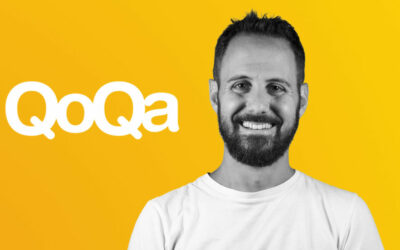QoQa is one of Switzerland’s largest e-commerce platforms. Founded in 2005 by Pascal Meyer, the concept is simple: select high-quality products, offer them at significant discounts, and sell them for only 24 hours with limited stock. Today, over 900,000 Swiss customers regularly shop on the platform. Over 15 years, QoQa has grown to 180 employees. We spoke with one of its leaders, Fabio Monte.
How did you decide to implement Holacracy?
It was a mix of two things: we first discovered it through our partner agency, Liip, which was passionate about Holacracy. Internally, people like Joann (leader of the web development circle) also pushed for it. We were intrigued and started researching it.
But what really convinced us was our lack of governance. When we passed the 100-employee mark, it became difficult to clearly define roles and responsibilities. We wanted to stay agile with the Scrum methodology, and Holacracy seemed like a way to maintain that flexibility.
What were the biggest surprises in adopting Holacracy?
The biggest surprise was how quickly our 180 employees adapted to it! After two years of research and training, the decision was obvious to me. But many colleagues hadn’t spent as much time studying it. I was pleased to see how quickly they embraced it, even if they didn’t fully understand all the implications at first.
Some external feedback was skeptical—people can be wary of the transparency that Holacracy brings. And some « leaders » feared losing power. But I believe everyone has now realized that power isn’t lost; it’s simply shared more broadly.
What internal steps did you take to ensure a successful transition?
COVID didn’t help—many of us were working remotely. But we invested heavily in training. The more people understand the nuances of Holacracy, the more likely they are to stick with it through challenges.
Supervision from external coaches at Ivolve and Semawe helped us identify obstacles and adapt. Having an external perspective allowed us to pause, address concerns, and refine our approach.
Can you tell us about your Holacracy training circle?
We created the QoQa Academy circle to support the transformation. Led by Christos, who coordinated everything from partner selection to training implementation, this circle ensures that anyone needing coaching or guidance can turn to a dedicated team.
This circle also acts as a filter, ensuring that internal coaches handle most issues and only escalate to external coaches when necessary. It provides structure and ensures that the transformation is well-supported at all levels.
What makes QoQa particularly compatible with Holacracy?
Our culture! We’ve always encouraged people to step beyond their defined roles. For example, Christos, originally a developer, took on Holacracy leadership. At QoQa, people feel free to voice ideas and take on new responsibilities. Holacracy formalizes that mindset and gives them the framework to go beyond just making suggestions—it allows them to act.
What challenges remain in your Holacracy practice?
One concern is that our governance system might not evolve as fast as the company itself. I worry that people may revert to old habits instead of fully integrating Holacracy.
Some employees still hesitate to take initiative in governance meetings, expecting former leaders to step in. We need to further embed the mindset that anyone can propose changes and actively shape our organization.
Have you noticed changes in your team?
Absolutely. A major shift occurred when I became the leader of the QoQa circle. Our founder, Pascal Meyer, remains highly involved, but our roles are now clearer, making collaboration more efficient.
Previously, some employees had informal leadership responsibilities without clear definitions. Now, they are officially recognized as circle leaders. This has encouraged them to take ownership of their roles and speak up more confidently. Some have even started asserting, “I am responsible for this role, so this decision should be mine.”
What are the biggest sensitivities around adopting Holacracy?
The HR side is delicate. While Holacracy defines roles, people still have traditional concerns about job titles, LinkedIn profiles, and salaries. We need to balance Holacracy’s flexible structure with external expectations about professional identity and compensation.
Another challenge is defining a clear vision. Even in a flexible system, an organization still needs a sense of direction. Many of our leaders are new to formal leadership and aren’t accustomed to setting long-term strategies. This is where traditional coaching and Holacracy must work together.
Any final advice for companies considering Holacracy?
Here are a few key lessons:
- Fast and clear internal communication is essential.
- Involve everyone early—offer concrete examples to help them understand the change.
- Choose the right Holacracy coach—they should understand your unique organizational culture, not just the rules of Holacracy.
Holacracy isn’t just about governance; it reshapes how people work individually and together. It’s a journey that transforms both the organization and the individuals within it!

Juliette Brunerie
Discover other articles written by the author!
Other articles .
Interview with Fabio Monte, leader of QoQa: Holacracy with a team of 180 people, an ambitious challenge
Interview with Fabio Monte, Leader at QoQa QoQa is one of the biggest players in the Swiss e-commerce market. The idea for this platform was launched in 2005 by its founder, Pascal Meyer. The concept is simple: handpicked products available for just 24 hours at...
How QoQa Managed to Successfully Implement Holacracy Using Holaspirit
Read the articleDiscover other articles written by the author!Other articles .
How is the Grenoble Metropolis inspired by Holacracy?
Discover How Holacracy Is Influencing and Inspiring Managers in the Grenoble Metropolis. Hélène Clot, Director of Strategy, Innovation, and Citizen Relations, shares her journey and how Holacracy is addressing key challenges in the public sector today. She explains...




